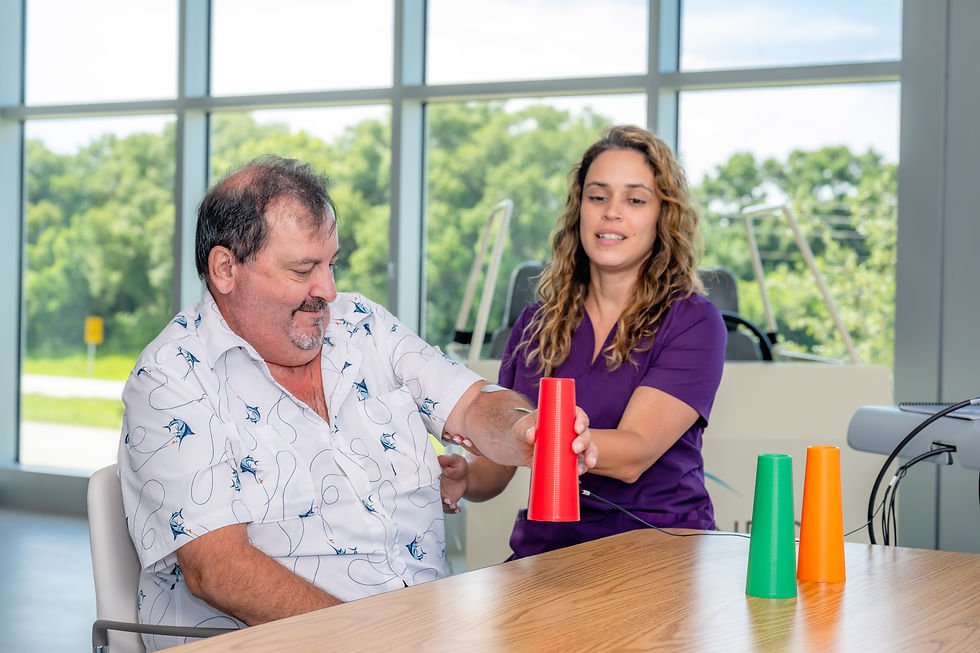Stroke Rehabilitation: What to Expect
- Shreveport Rehabilitation Hospital

- May 17, 2021
- 3 min read
Updated: May 25, 2021
Stroke Rehabilitation: What to Expect
Recovery after a stroke varies for each person depending on the type and the severity of the stroke. However, with inpatient medical rehabilitation, post-stroke patients can achieve the best possible long-term outcome.
More than 800,000 people in the U.S. experience a stroke each year, and 10 percent recover almost completely. For all stroke survivors, rehabilitation can substantially help patients relearn skills such as talking, walking, eating, and other skills impacted by the stroke and damage to the brain. While rehab therapy can not undo the effects of a stroke, rehabilitation can help patients minimize lasting effects and regain as much independence as possible.
What is a stroke?
A stroke is a sudden interruption in the blood supply to the brain typically caused by an abrupt blockage of arteries leading to the brain. Other strokes are caused by bleeding into the brain tissue when a blood vessel bursts. Strokes occur quite rapidly and require immediate treatment; therefore, a stroke has also been referred to as a 'brain attack.' When symptoms of a stroke only last a short time (less than an hour), these events are called a transient ischemic attack (TIA) or are often referred to as a mini-stroke.
The effects of a stroke depend on which part of the brain is injured, and how severely it is damaged. Strokes may cause sudden weakness, loss of sensation, or difficulty speaking, seeing, or walking.
When does rehabilitation start?
Rehabilitation therapy can begin as early as a day or two after a patient experiences a stroke. The patient's health is first stabilized, and the patient's ability to participate in rehab therapy is assessed. Some patients need more recovery time or other medical treatment before transitioning to an intensive rehab program. Patients can expect around 3 hours of therapy daily that comprises physical therapy, occupational therapy, and speech therapy.

Stroke Treatment Team
At an acute inpatient rehabilitation hospital like Shreveport Rehabilitation Hospital, patients will have a team of health care providers, including specialized rehab physicians and nurses, physical therapists, speech therapists, and occupational therapists. This multidisciplinary approach ensures the patient's goals are achieved, and the patient returns to the highest function possible.
Physicians include a team of both physical medicine rehabilitation physicians and other physician specialists to examine and order the type of treatments, medications, and therapies required for the patient.
Physical therapy will help improve muscle strength and coordination, decrease muscle tension and regain range of motion. Physical therapy can help with paralysis, one of the most common disabilities resulting from stroke and ataxia, when the body has trouble controlling movement. The latter can lead to problems with body posture, walking, and balance.
Occupational therapy will help patients relearn how to do familiar tasks like eating and dressing to help them regain as much independence as possible. Occupational therapy also helps patients learn to use adaptive equipment like walking aids to help stabilize loss of balance from the stroke.
Speech therapy helps patients regain abilities like swallowing, speaking, listening, writing, and comprehension. At least 25 percent of stroke survivors experience language impairments such as aphasia (inability to convey thoughts) and dysphagia (problems swallowing).
The stroke treatment team addresses the physical impairments and the psychological impairments such as depression and other psychosocial impacts from the stroke. The recovery process is unique to each patient, and an individualized plan of care is established with each patient. The engagement by the patient with the treatment team and the therapy plan, as well as a strong support system of family and loved ones, leads to the highest possible outcomes.
How Shreveport Rehabilitation Hospital can help
Our specialized team of stroke rehabilitation experts works together daily, sharing their expertise to create a comprehensive, well-rounded individualized stroke program focusing on addressing the patient's physical, cognitive, psychological, social, educational, and work-related needs. For a stroke patient, getting back to living may be as simple as regaining the ability to shower and get dressed. It may be relearning how to speak for other patients, socializing with friends and loved ones, or even driving to work.
Shreveport Rehabilitation Hospital offers this multidisciplinary approach in a state-of-the-art medical hospital with advanced technology in a new and modern environment to help patients return to the healthiest and highest level of independent living.











